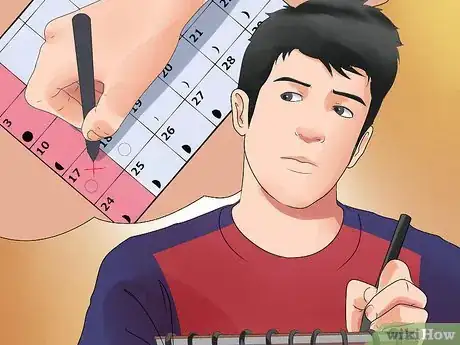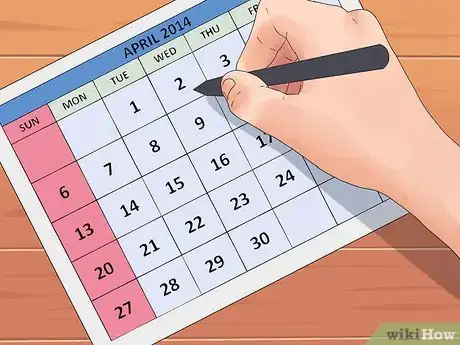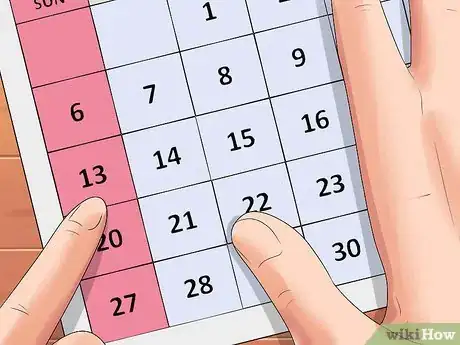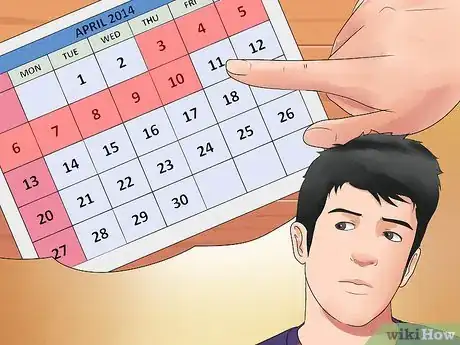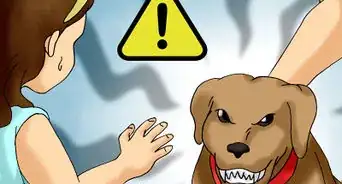wikiHow is a “wiki,” similar to Wikipedia, which means that many of our articles are co-written by multiple authors. To create this article, volunteer authors worked to edit and improve it over time.
This article has been viewed 96,382 times.
Learn more...
Easter is not celebrated on a fixed date and can fall anywhere between March 22 and April 25. To determine when Easter is in any given year, you'll need to pay attention to the lunar cycle and the date of the March equinox.
Steps
Determining the Date of Easter
-
1Mark the vernal equinox. The date Easter falls on is based on the ecclesiastical approximation of the vernal (spring) equinox. This approximation falls on the same date each year: March 21.
- Note that this calculation relies on the ecclesiastical estimation of the vernal equinox, not the actual vernal equinox identified by the astronomical system of measurement. The actual moment of equinox can shift within 24 hours and may arrive a day before March 21. This is not taken into consideration when the date of Easter is determined, however.
- This is the vernal equinox in the Northern Hemisphere only. For those in the Southern Hemisphere, it is the autumnal equinox. The same date (March 21) is used in both hemispheres, though.
-
2Find the date of the first full moon. Identify the date of the first full moon that comes after the vernal equinox. This date will land no later than a month after the vernal equinox.
- You can find out this information by checking a lunar calendar. These calendars track and illustrate the day-by-day phases of the moon. You can buy a lunar wall or desk calendar, or you can search for a free one online.
Advertisement -
3Skip ahead to the following Sunday. The Sunday after the first moon following the vernal equinox is the date that Easter falls on.[1]
- For example, the first full moon after the vernal equinox in 2014 came on Tuesday, April 15.[2] This means that in 2014, Easter fell on the following Sunday, April 20.
-
4Note whether or not the full moon falls on Sunday. If the first full moon after the vernal equinox lands on a Sunday, the date of Easter is delayed by one week and lands on the following Sunday.
- This delay is put into place to decrease the risk of Easter Sunday landing on the same day as the Jewish Passover.
- For instance, the first full moon after the vernal equinox in 1994 fell on Sunday, March 27.[3] Instead of Easter also falling on March 27, it fell a week later on Sunday, April 3.
Determining Dates Related to Easter
-
1Back up one week to find Palm Sunday. Palm Sunday is exactly one week before Easter.
- Palm Sunday celebrates Christ's entry into Jerusalem. It also marks the beginning of Holy Week.
-
2Pay special attention to the week in between Palm Sunday and Easter. The entire week is often referred to as “Holy Week,” but the Thursday, Friday, and Saturday immediately before Easter in particular are recognized as dates of significance in the Christian calendar.
- Maundy Thursday celebrates the Last Supper of Christ. It also recognizes the "washing of feet," a biblical event during which Jesus washed the feet of his Apostles. Many Christian denominations celebrate the maundy (washing of feet) as a church ordinance.
- Good Friday recognizes the day that Christ was crucified.
- Holy Saturday commemorates the time during which Christ's body lay in the tomb. It is typically viewed as a day of preparation for Easter Sunday.
-
3Count back to the Wednesday six weeks before Easter. Trace back to the Sunday that came six calendar weeks earlier. The Wednesday immediately before that date is Ash Wednesday.
- In other words, Ash Wednesday is 46 days before Easter each year.
- Ash Wednesday is a formal day of repentance in many Christian churches.
- It also marks the first day of Lent, a period of 40 days over which Christians are to spiritually prepare for Easter.
-
4Count 40 days ahead. Ascension Day is a Christian holiday that falls exactly 39 days after Easter Sunday.[4]
- Ascension Day celebrates Christ's ascension into heaven. In some Christian denominations, it is also considered the “fortieth day of Easter,” meaning that all the days in between Easter Sunday and Ascension Day are part of the broader Easter season.
Taking Additional Considerations
-
1Understand the history. Easter has always been celebrated near the date of the Jewish Passover, but the exact method of determining the date on which to celebrate Easter has changed slightly over the centuries.
- Easter is a celebration of Christ's return from the dead after His crucifixion.
- In the Bible, Jesus rose from the dead on the first Sunday following the Jewish Passover. Passover begins on the fifteenth day of the month of Nisan in the Hebrew calendar. This roughly corresponds to the first full moon after the March equinox, but the Hebrew calendar is not based on the cycles of the moon, so the timing is not exact.
- Since the date of Passover needed to be announced each year by Jewish officials, early Christian leaders simplified the date of Easter by scheduling it consistently for the Sunday after the full moon. This happened in 325 CE and was an official declaration of the Council of Nicaea.[5]
- The practice of using the moon and equinox as a dating system actually has ties to pagan practices, though. Religious dates were never previously established using astronomical events in the Jewish tradition from which most of Christian tradition arose. The practice of doing so was pagan in nature, but early Christians adopted it for the sake of simplifying their own dating system.
-
2Note the difference between Gregorian and Julian calendars. Most Western churches (Roman Catholics and most Protestants) follow the standard calendar, also known as the Gregorian calendar. Some Orthodox Christian churches still use the Julian calendar to determine the date of Easter.
- The Gregorian calendar was created when scientists discovered that the Julian calendar was too long. The dates of both calendars are similar, but slightly different.
- The Gregorian calendar is more accurately aligned to the equinox.
-
3Remember the time frame. According to either calendar, Easter will always fall between March 22 and April 25.
- This time frame does not occur over the same set of days for both calendars, though. If you are observing the Gregorian calendar like most do, the Easter time frame in the Julian calendar would actually run from April 3 to May 10.
-
4Watch for possible reforms to the date. Several churches and nations have proposed various reforms to the manner in which the date of Easter is determined, but so far, none of these reforms have been put into practice.
- In 1997, the World Council of Churches discussed the possibility of replacing the current system of calculation with an equation-based method of calculation that depended more directly on astronomical events. This reform was scheduled for 2001 but was never actually adopted.
- In 1928, the United Kingdom actually fixed the date of Easter as the first Sunday after the second Saturday in April, but the act putting it into law was never actually implemented and the reform was never followed.
Community Q&A
-
QuestionWhy are the Sundays during Esther period not counted when determining Ash Wednesday?
 Community AnswerTraditionally, Catholics may break the Lenten fast on Sunday. Because Lent is a 40 day fast, Easter is 40 days after Ash Wednesday, not including Sundays.
Community AnswerTraditionally, Catholics may break the Lenten fast on Sunday. Because Lent is a 40 day fast, Easter is 40 days after Ash Wednesday, not including Sundays. -
QuestionThere is a full moon this week, which is the first full moon after the equinox. Why is Easter not the 24th of March?
 Community AnswerEaster occurs on the 1st Sunday after the paschal full moon. The paschal full moon is the 1st full moon after the vernal equinox. The Church always recognises the equinox as being the 21st of March. The equinox can be on the 20th of March instead, like it is this year (2019). However, the Church only recognise the 21st as the equinox. Therefore, the 1st full moon after the 21st March is the 19th of April - the 1st Sunday after the full moon is the 21st of April, setting the date for Easter.
Community AnswerEaster occurs on the 1st Sunday after the paschal full moon. The paschal full moon is the 1st full moon after the vernal equinox. The Church always recognises the equinox as being the 21st of March. The equinox can be on the 20th of March instead, like it is this year (2019). However, the Church only recognise the 21st as the equinox. Therefore, the 1st full moon after the 21st March is the 19th of April - the 1st Sunday after the full moon is the 21st of April, setting the date for Easter. -
QuestionHow many full moons are there in a year?
 MoonAngle53Community AnswerA year is about 365.25 days, so there should be 12.37 full cycles of lunar phases per year (dividing 365.25 days per year by 29.531 days per lunar cycle), which means 12 full cycles—so 12 full moons in a year.
MoonAngle53Community AnswerA year is about 365.25 days, so there should be 12.37 full cycles of lunar phases per year (dividing 365.25 days per year by 29.531 days per lunar cycle), which means 12 full cycles—so 12 full moons in a year.
References
About This Article
To determine when Easter is, look on a calendar for the Sunday following the first full moon after March 21. Alternatively, if you know when Palm Sunday occurs, simply look forward 1 week to the next Sunday to figure out when Easter will be. You can also count forward 46 days from Ash Wednesday to find the date Easter will fall on. To learn how to date Easter according to when Ascension Day takes place, keep reading!

